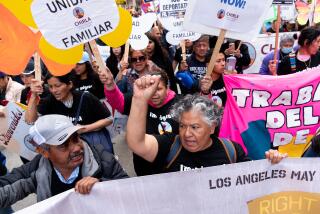Editorial: Whether View Park is a national historic place or not, things are changing there.
When two black sisters bought a house in View Park in the 1950s, becoming one of the first black families to own property there, white neighbors set their lawn on fire. Nonetheless, well-to-do and prominent blacks steadily moved in while white homeowners fled. And for the last half century, the South L.A. neighborhood has been a bastion of black affluence and cohesiveness.
Professionals, entertainers and entrepreneurs, including Ray Charles, Curt Flood and Ike and Tina Turner, bought architecturally distinctive Spanish and American colonial revival homes as well as modern ranch style houses, set on palm-lined hillside streets in a neighborhood tucked between La Brea Avenue and Crenshaw Boulevard in unincorporated L.A. County. The story of View Park’s evolution led a large group of homeowners to undertake the costly and time-consuming process of applying to put the neighborhood on the National Register of Historic Places.
The designation, expected to be granted any day now, would enshrine View Park as a historically black community, promote civic pride, allow many to qualify for tax credits for maintaining and rehabilitating their homes, and, quite possibly, raise property values. However, another group, small but vocal, says that pride in the community’s heritage should have stopped residents from seeking National Register status. In a worst-case scenario, these critics argue, the designation will put a spotlight on the community, attracting a crush of house hunters and house flippers. The turnover would accelerate a change in the profile of the neighborhood, drawing in white homebuyers while pushing it out of many blacks’ reach.
It’s true that View Park is no longer a hidden gem. But keeping it off the National Register would not keep the neighborhood a secret. View Park is part of a real estate juggernaut that started before that application and will continue whether the neighborhood ascends to the register or not.
A new Metro rail line is under construction nearby. Billions of dollars are being invested in commercial development in the area. And the county as a whole is starved for housing inventory. The average sales price for View Park homes has increased by 61% and the median by 46% since 2011, when the local housing market hit its post-housing-bubble bottom.
One realtor, an African-American who lives in View Park, says that nine out of the last 10 homes she sold there went to white buyers.
Black people are still buying in View Park, which remains about 84% black. But the neighborhood is attracting a more diverse clientele. One realtor, an African-American who lives in View Park, says that nine out of the last 10 homes she sold there went to white buyers.
In the end, whether View Park residents believe the National Register designation was sought as a ploy to jack up property values or a community honor, it’s still a noteworthy distinction. Yet it will have little physical effect on the neighborhood, beyond some signs on the streets denoting its status as a historic place. The designation imposes no restrictions on demolition or remodeling of the architecturally important homes. This is not the equivalent of becoming a county-approved local historic district. Getting that status is an entirely different process and, among other steps, requires 51% of the owners to agree to it.
Nevertheless, the brouhaha over the designation has illuminated some of the harsher elements of this neighborhood’s history — the old racist covenants that said the only black people who could live in View Park were servants to the white homeowners, the cruelty of the white residents who lashed out at blacks who eventually bought in as homeowners, and the perseverance required to stick that out. All that is part of the legacy too, and it is not forgotten by many who still live there. For some, it engenders a wariness of any effort that might be interpreted as an attempt to take advantage of blacks there today.
Many people in View Park say they embrace diversity. Of course, they should. That’s what this entire country continues to fight for. But it would be prudent and honorable if everyone in View Park — black, white, newly arrived, long-ensconced — could be mindful of how much pain still lingers from that history.
Follow the Opinion section on Twitter @latimesopinion or Facebook
More to Read
A cure for the common opinion
Get thought-provoking perspectives with our weekly newsletter.
You may occasionally receive promotional content from the Los Angeles Times.










